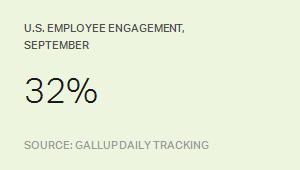Story Highlights
- Millennials may thrive in their physical wellbeing, but not financial
- Gen X is in deep debt with greater stress and pressure to "step up"
- Baby Boomers are close to retirement but still have wellbeing needs
Gallup research has revealed five interconnected elements of wellbeing -- career, social, financial, physical and community wellbeing -- that affect everything from our job performance to our health status.
But just one out of 14 people is thriving in all five elements.
Clearly, thinking of wellbeing as a workplace issue can create a healthier -- and more productive -- workforce. But leaders need to understand that while wellbeing is always individual and personal, different generations bring differing wellbeing needs to work with them. To increase the number of thriving employees in your organization, it's worth understanding wellbeing the way your employees do.
Millennials: Born Between 1980 and 1996
Millennials are more likely than other generations to be thriving in their physical wellbeing. They're the most likely to use your on-site fitness center or join the company intramural team.
However, millennials have a higher debt-to-income ratio and lower net worth than the previous generations. They may be struggling, or worse, with their financial wellbeing.
Your biggest opportunity to impact this generation's wellbeing may be to help them deal with the stress of their finances.
While most companies can't erase the financial burden of, say, college debt, they can provide a culture of psychological safety that allows millennials to talk about their financial goals with their manager -- and internal or external financial experts if possible -- without embarrassment. At Gallup, we created an eight-week course geared toward millennials' financial concerns. Their feedback told us they were thrilled to learn from experts and relieved to know many of their peers were in similar financial situations.
Let millennials be millennials or they'll find a company that does.
But don't expect them to value big purchases like houses or cars the way their elders did back in the day. Millennials appreciate experiences more than things, which is actually a hallmark of wellbeing, according to Gallup research. We've found that the return on vacations and outings with friends is measured emotionally, and it's far greater than the emotional return people get from buying tangible goods.
The emphasis on experiences over stuff may help explain the premium millennials put on recognition and their well-chronicled "fear of missing out." They grew up on social media where every experience can be displayed, so a sharp line between "work" and "life" can hinder their social, community and career wellbeing.
So, don't draw that line.
Let millennials tell their stories and post their pictures. Ask about their adventures in meetings or one-on-one conversations. Let them bring their whole selves to work because 50% of them say they might be with another employer in one year. Let millennials be millennials or they'll find a company that does.
Generation X: Born Between 1965 and 1979
Generation X is more deeply in debt than millennials, but they have a different kind of stress about it. Gen Xers have higher earnings but many are taking on the same college debt millennials have, though on behalf of their children, while caring for aging parents as well. For some, it's a perfect storm of financial, emotional, and time-pressure stress. Their financial education and encouragement should acknowledge that this situation is not unusual -- nor unmanageable -- through appropriately designed tools, resources and support groups. Caregiving is more than providing financial support, it also involves emotional labor and the sacrifice of time and personal plans, which can undermine wellbeing, naturally.
Meanwhile, Gen Xers are now old enough to contribute to or lead community activities -- and Gen Xers may feel they have little choice but to step up. Gen Xers spend far more time with their children than their parents did, have bigger families than millennials do, and it's a small generation. If they don't join the PTA or booster club, it can seem like no one else will.
For some, it's a perfect storm of financial, emotional and time-pressure stress.
To lend our support to our employees' volunteer efforts, Gallup has a program called Community Builders. We match employee contributions given to select local nonprofits because it amplifies our employees' efforts ... and because we know people who feel included in the place where they live have greater community and social wellbeing.
Still, volunteer activities cost Gen Xers time and energy, and caring for others can seem more important than their own physical wellbeing.
Sure, Gen Xers know they need to hit the gym and watch what they eat, but they may not bother to learn their blood pressure and cholesterol level, respect the impact of sleep deprivation and stress, or establish a meaningful relationship with a primary care physician.
That's why we stopped conducting annual on-site biometric screenings a few years ago. Now Gallup encourages employees to complete the check-in with a doctor of their choosing. It helps our staff create more meaningful and holistic relationships with doctors and allows for broader conversations than our workers could have during the health screenings.
Baby Boomers: Born Between 1946 and 1964
Baby boomers are moving into the tail-end of their careers, but that doesn't mean they all want to finish strong and ride off into the sunset. Boomers are often thought of as loyal to employers and teams and want to contribute whole-heartedly to the organization until they feel like they're done.
Which is when they feel they can afford it -- and rising healthcare costs mean many can't.
Your company's health benefits play an important part in this. While coverage differs among employees, all retirees will be eligible for federal programs at some point. Your baby boomer employees need to understand how their employee plan will mesh with their next one, and it can be complicated. An HR department that can guide boomers through this complicated landscape can promote their physical wellbeing well past their last day of work. And there's no brand advocate like an enthusiastic alumnus, so HR's effort can have a positive effect on the company, too.
Boomers may not understand millennial culture or Gen Xers' approach to parenting, but they do know how to conduct a career.
But leaders can help boomers optimize healthy living long before they leave the company by teaching them this one valuable metric: "having enough energy to do the things you want to do each day." That metric comes from extensive Gallup research, so it's the gold standard. And it allows leaders to offer the same wellness program to everyone -- you don't have to revamp your gym to suit boomers' workout style -- as long as it ensures a health plan that allows boomers to execute what they love to do most every day and furthers their sense of purpose.
Boomers' workplace loyalty and financial insecurity might influence your succession planning, so train your managers to coach boomers with compassion for the individual and with care for the organization.
And managers can amplify boomers' sense of career wellbeing (and leverage their hard-won expertise) by asking them to serve as career mentors. Boomers may not understand millennial culture or Gen Xers' approach to parenting, but they do know how to conduct a career.
Support Wellbeing Needs With Sensitivity to Improve Outcomes
Wellbeing is a people-first paradigm that humanizes the workplace. Though it serves a much bigger purpose than just reducing healthcare costs and risks, those costs can be substantial: One small study at some Midwestern commercial laundry plants found that employees enrolled in their employer-sponsored health program increased their productivity by about 4% on average during the subsequent year -- 10.8% among certain workers whose health improved between annual screenings -- and the wellness program's return on the laundry plant's investment was 76.3%.
That's excellent news for businesses, but wellbeing's benefits are felt on an individual level as well. Wellbeing creates thriving lives and thriving employees. But only if leaders support it.
That support, which must extend down to managers and champions within the organization, keeps wellbeing initiatives alive. An overarching culture of wellbeing supported by leadership is crucial to wellbeing initiatives.
Leaders who recognize that different generations have different wellbeing issues support employee wellbeing in an especially sensitive way. That sensitivity and care increase the likelihood of successful wellbeing initiative outcomes -- and the number of thriving employees.
Want to learn more about creating a workplace culture that promotes and supports wellbeing for every generation?
- Partner with Gallup to create a culture of wellbeing and support for employees.
- Download Gallup's perspective paper, Designing Your Organization's Employee Experience, to understand the importance of wellbeing throughout the entire employee life cycle.
- Empower your managers to improve team wellbeing with Gallup Access.





